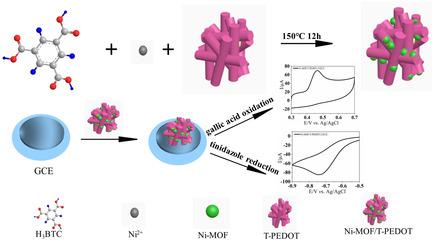当前位置:
X-MOL 学术
›
ChemElectroChem
›
论文详情
Our official English website, www.x-mol.net, welcomes your
feedback! (Note: you will need to create a separate account there.)
Nickel‐Based Metal‐Organic Framework/Crosslinked Tubular Poly(3,4‐ethylenedioxythiophene) Composite as an Electrocatalyst for the Detection of Gallic Acid and Tinidazole
ChemElectroChem ( IF 3.5 ) Pub Date : 2020-09-21 , DOI: 10.1002/celc.202000991 Haixu Wang 1 , Xiaogeng Feng 1 , Xiangjie Bo 1 , Ming Zhou 1 , Liping Guo 2
ChemElectroChem ( IF 3.5 ) Pub Date : 2020-09-21 , DOI: 10.1002/celc.202000991 Haixu Wang 1 , Xiaogeng Feng 1 , Xiangjie Bo 1 , Ming Zhou 1 , Liping Guo 2
Affiliation

|
Nickel‐based metal‐organic framework (Ni‐MOF) embedded in tubular poly(3,4‐ethylenedioxythiophene) (T‐PEDOT) composites was first synthesized through the in situ growth of Ni‐MOF with T‐PEDOT. The incorporation of T‐PEDOT and Ni‐MOF enhances the conductivity of Ni‐MOF/T‐PEDOT, reduces aggregation and restricts the size of Ni‐MOF, and exposes more active sites of the Ni‐MOF. Compared with Ni‐MOF, Ni‐MOF/T‐PEDOT manifests improved electrocatalytic activity toward the oxidation and reduction of gallic acid and tinidazole, respectively. The Ni‐MOF/T‐PEDOT‐2/glassy carbon electrode (GCE) as a novel electrochemical sensor was constructed to detect two antibacterial drugs. Ni‐MOF/T‐PEDOT‐2/GCE shows two linear responses to gallic acid in the range of 0.8–25.5 μM and 25.5–150 μM, with a high sensitivity of 0.559 μA μM−1. At the same time, Ni‐MOF/T‐PEDOT‐2/GCE exhibits two linear responses to tinidazole in the range of 0.7–35 μM and 35–255 μM. Therefore, Ni‐MOF/T‐PEDOT‐2/GCE could be used to detect gallic acid and tinidazole in real samples with satisfactory results. Recovery values varied from 95.1 to 104.2 % for gallic acid sensing and 94.2 to 104.2 % for tinidazole sensing, which demonstrates that the sensor has practical application for gallic acid and tinidazole detection. Our work offers an efficient strategy for fabricating a new electrocatalysts based on MOFs and tubular conductive polymer.
中文翻译:

镍基金属有机骨架/交联管状聚(3,4-乙烯二氧噻吩)复合材料作为电催化剂用于检测没食子酸和替硝唑
嵌入在管状聚(3,4-乙撑二氧噻吩)(T-PEDOT)复合材料中的镍基金属有机骨架(Ni-MOF)首先通过Ni-MOF与T-PEDOT的原位生长合成。T-PEDOT和Ni-MOF的结合提高了Ni-MOF / T-PEDOT的电导率,减少了聚集并限制了Ni-MOF的尺寸,并暴露了Ni-MOF的更多活性位。与Ni-MOF相比,Ni-MOF / T-PEDOT分别显示出对没食子酸和替硝唑的氧化和还原具有更好的电催化活性。Ni-MOF / T-PEDOT-2 /玻碳电极(GCE)作为新型电化学传感器,可检测两种抗菌药物。Ni‐MOF / T‐PEDOT‐2 / GCE对没食子酸有两种线性响应,范围分别为0.8–25.5μM和25.5–150μM,灵敏度为0.559μAμM -1。同时,Ni-MOF / T-PEDOT-2-GCE对替硝唑表现出两种线性响应,范围为0.7-35μM和35-255μM。因此,Ni-MOF / T-PEDOT-2-GCE可用于检测真实样品中的没食子酸和替硝唑,结果令人满意。没食子酸感测的回收率值从95.1%到104.2%不等,替硝唑感测的回收率值从94.2%到104.2%不等,这表明该传感器在没食子酸和替硝唑的检测中具有实际应用。我们的工作为基于MOF和管状导电聚合物的新型电催化剂的制备提供了有效的策略。
更新日期:2020-10-12
中文翻译:

镍基金属有机骨架/交联管状聚(3,4-乙烯二氧噻吩)复合材料作为电催化剂用于检测没食子酸和替硝唑
嵌入在管状聚(3,4-乙撑二氧噻吩)(T-PEDOT)复合材料中的镍基金属有机骨架(Ni-MOF)首先通过Ni-MOF与T-PEDOT的原位生长合成。T-PEDOT和Ni-MOF的结合提高了Ni-MOF / T-PEDOT的电导率,减少了聚集并限制了Ni-MOF的尺寸,并暴露了Ni-MOF的更多活性位。与Ni-MOF相比,Ni-MOF / T-PEDOT分别显示出对没食子酸和替硝唑的氧化和还原具有更好的电催化活性。Ni-MOF / T-PEDOT-2 /玻碳电极(GCE)作为新型电化学传感器,可检测两种抗菌药物。Ni‐MOF / T‐PEDOT‐2 / GCE对没食子酸有两种线性响应,范围分别为0.8–25.5μM和25.5–150μM,灵敏度为0.559μAμM -1。同时,Ni-MOF / T-PEDOT-2-GCE对替硝唑表现出两种线性响应,范围为0.7-35μM和35-255μM。因此,Ni-MOF / T-PEDOT-2-GCE可用于检测真实样品中的没食子酸和替硝唑,结果令人满意。没食子酸感测的回收率值从95.1%到104.2%不等,替硝唑感测的回收率值从94.2%到104.2%不等,这表明该传感器在没食子酸和替硝唑的检测中具有实际应用。我们的工作为基于MOF和管状导电聚合物的新型电催化剂的制备提供了有效的策略。











































 京公网安备 11010802027423号
京公网安备 11010802027423号